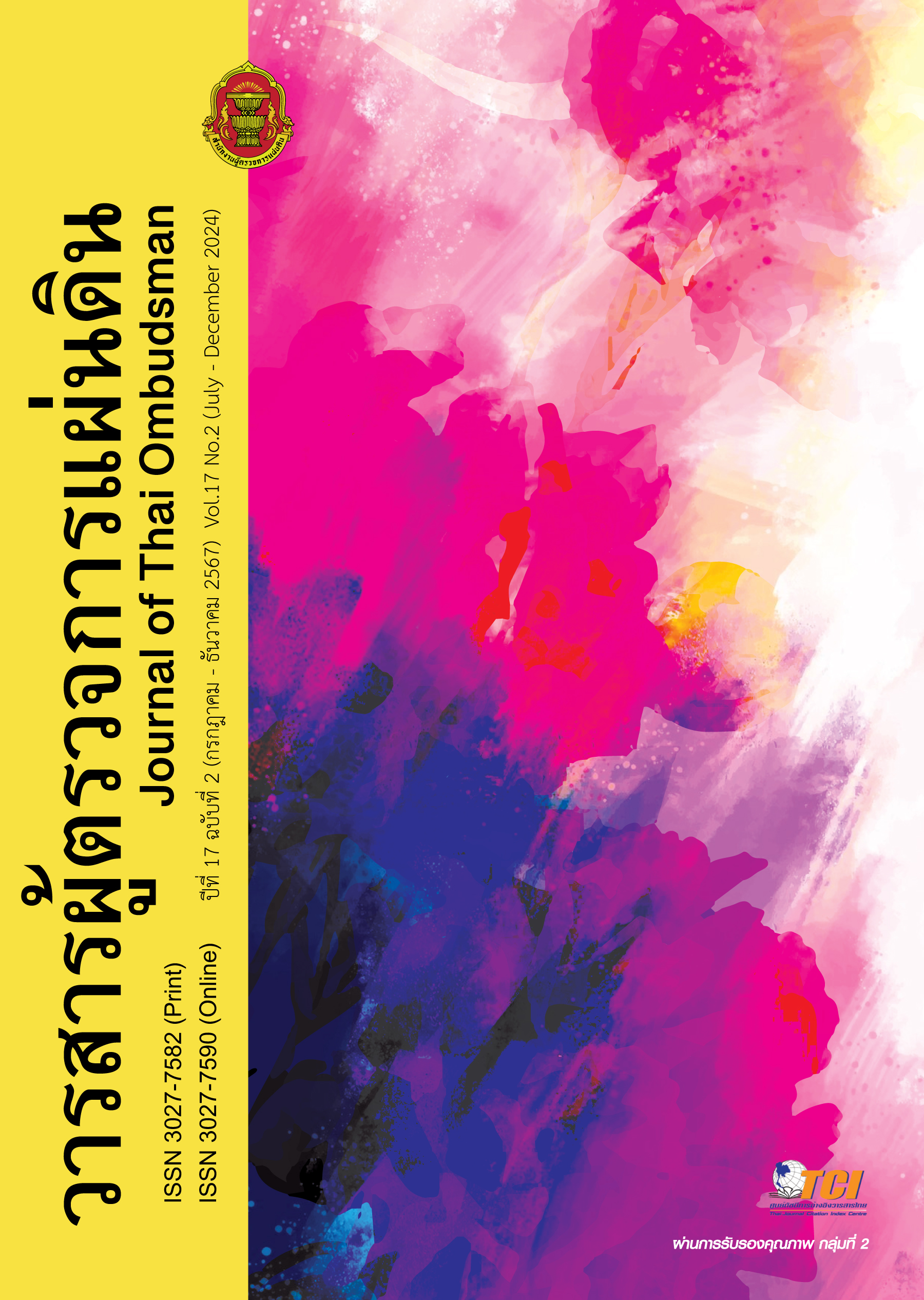ศพไร้ญาติ: การสืบสาววาทกรรมเกี่ยวกับการจัดการศพไร้ญาติของรัฐไทย
คำสำคัญ:
ศพไร้ญาติ, การจัดการของภาครัฐ, การสืบสาววาทกรรม, มูลนิธิจีนบทคัดย่อ
การเปลี่ยนแปลงทางโครงสร้างของประชากรไทยอาจนำไปสู่ประเด็นปัญหาเกี่ยวกับการมีผู้สูญเสียชีวิตที่ไม่มีผู้ดูแลจัดการศพ หรือที่อาจเรียกว่า “ศพไร้ญาติ” มากขึ้นในอนาคต อนึ่ง การจัดการศพไร้ญาติของไทยมีลักษณะที่แตกต่างจากหลายประเทศ เนื่องจากลักษณะของพัฒนาการทางประวัติศาสตร์ของไทยทำให้การจัดการเกี่ยวกับศพไร้ญาติกลายเป็นภารกิจของมูลนิธิคนจีน บทความวิชาการนี้มีวัตถุประสงค์เพื่อศึกษาการให้ความหมายและข้อพิจารณาเกี่ยวกับประเด็นศพไร้ญาติของรัฐไทย ผ่านระเบียบวิธีการวิเคราะห์แบบสืบสาววาทกรรมและกรอบทฤษฎีเกี่ยวกับการทำให้เป็นสมัยใหม่ของความตาย ในการชี้ให้เห็นความสัมพันธ์ของการจัดการศพไร้ญาติจากระดับมหภาค ระดับกลาง และระดับจุลภาค ผลการศึกษาพบว่ารัฐไทยพิจารณาศพไร้ญาติจากมุมมองด้านสุขอนามัย ทว่ากลุ่มมูลนิธิคนจีนพิจารณาศพคนตายจากมุมมองด้านความเชื่อทางศาสนาซึ่งสามารถผลักดันเข้าสู่กระบวนการจัดการของภาครัฐ และมีอิทธิพลต่อความคิดของคนในสังคมทำให้การจัดการศพไร้ญาติกลายเป็นเรื่องของมูลนิธิจีนมากกว่าภารกิจของรัฐไทยไปโดยปริยาย
เอกสารอ้างอิง
กรมกิจการผู้สูงอายุ. (2561). คู่มือการดำเนินโครงการการสนับสนุนการจัดการศพผู้สูงอายุตามประเพณี ประจำปีงบประมาณ 2562. กรุงเทพมหานคร: กระทรวงพัฒนาสังคมและความมั่นคงของมนุษย์.
กระทรวงการพัฒนาสังคมและความมั่นคงของมนุษย์. (2557) ประกาศกระทรวงการพัฒนาสังคมและความมั่นคงของมนุษย์ เรื่อง กำหนดหลักเกณฑ์ วิธีการ และเงื่อนไขการคุ้มครอง การส่งเสริม และการสนับสนุนการสงเคราะห์ในการจัดการศพตามประเพณี พ.ศ. 2557. ใน ราชกิจจานุเบกษา เล่ม 131 ตอนพิเศษ 207 ง, (หน้า15–17). กรุงเทพมหานคร: สำนักพิมพ์คณะรัฐมนตรีและราชกิจจานุเบกษา.
กรรณิการ์ ตันประเสริฐ และคณะ. (2543). 90 ปีมูลนิธิป่อเต็กตึ๊งบนเส้นทางประวัติศาสตร์สังคมไทย: ประวัติศาสตร์จากคำบอกเล่า. กรุงเทพฯ: สภามหาวิทยาลัยหัวเฉียวเฉลิมพระเกียรติ.
กัณฐิกา ศรีอุดม. (2546). ร.5 เสด็จอินเดีย โดย สาดชิดอนันท สหาย. กรุงเทพฯ: มูลนิธิโครงการตำราสังคมศาสตร์และมนุษย์ศาสตร์.
ไทยรัฐออนไลน์. (2558) ‘ป่อเต็กตึ๊ง’ล้างป่าช้าประจำปี เตรียมเผา 2,002 ศพ ทารกวัดไผ่เงิน. ค้นเมื่อ 1 มีนาคม 2563. จาก https://www.thairath.co.th/news/local/536045.
นฤพนธ์ ด้วงวิเศษ และปัณวัฒน์ ผ่องจิต. (2560). ชุมชนกับความเชื่อสิ่งศักดิ์สิทธิ์ในอำเภอบ้านแพ้วและอำเภอกระทุ่มแบน จังหวัดสมุทรสาคร. กรุงเทพฯ: ศูนย์มานุษยวิทยาสิรินธร.
ปอล ซาเวียร์. (2530). ประวัติศาสตร์แห่งพระราชอาณจักรสยาม โดย ฟรังซัวร์ อังรี ตุรแปง. กรุงเทพฯ: กรมศิลปากร.
พระราชกำหนดศุขาภิบาล รัตนโกสินทร์ศก 116. (2440). ใน ราชกิจจานุเบกษา เล่ม 14. (หน้า 517–525). กรุงเทพมหานคร: สำนักพิมพ์คณะรัฐมนตรีและราชกิจจานุเบกษา.
พระราชบัญญัติการสาธารณสุข พุทธศักราช 2477. (2478). ใน ราชกิจจานุเบกษา เล่ม 52. (หน้า 281–318). กรุงเทพมหานคร: สำนักพิมพ์คณะรัฐมนตรีและราชกิจจานุเบกษา.
พระราชบัญญัติสุขาภิบาล พ.ศ. 2495. (2495). ใน ราชกิจจานุเบกษา ตอนที่ 63 เล่มที่ 69. (หน้า 1261–1276). กรุงเทพมหานคร: สำนักพิมพ์คณะรัฐมนตรีและราชกิจจานุเบกษา.
วัลภา บุรุษพัฒน์. (2517). ความเป็นมาของชาวจีนในประเทศไทย. ใน ขจัดภัย บุรุษพัฒน์ (บรรณาธิการ). ชาวจีนในประเทศไทย. (หน้า1–42). กรุงเทพฯ: แพร่พิทยา.
ศิลปวัฒนธรรม. (2562). กําเนิดป่อเต็กตึ๊ง คณะเก็บศพฯที่ ร.6 พระราชทานทุน สู่แรงบันดาลใจของ บิณฑ์ บรรลือฤทธิ์. ค้นเมื่อ 1 มีนาคม 2563. จาก https://www.silpa-mag.com/history/article_38908.
สถาบันนิติเวชวิทยา. มูลนิธิสถาบันนิติเวชวิทยา. ค้นเมื่อ 1 มีนาคม 2563. จาก http://www.ifm.go.th/index.php/ifm-foundation/136-history-of-ifm-foundation.
Aries, P. (1974). Western Attitudes Toward Death from the Middle Ages to the Present. Baltimore and London: The Johns Hopkins University Press.
Barilan, Y. M. (2006). Bodyworlds and the Ethics of Using Human Remains: A Preliminary Discussion. Bioethics,20(5), 233–247.
Cook County Government. Virtual Cemetery. Retrieved May 7, 2020. from https://www.cookcountyil.gov/ service/virtual-cemetery.
Elias, Norbert. (1985). The Loneliness of Dying. New York: Continuum.
Friesen, Mark. (2009). Disposition of Unclaimed Bodies in U.S. Varies by State, Jurisdiction. Retrieved May 7, 2020, from https://www.oregonlive.com/special/2009/06/disposition_of_unclaimed_bodie.html
Hakola, Outi, Sara Heinämaa, and Sami Pihlström. (2015). Death and Mortality: From Individual to Communal Perspectives. Helsinki: Helsinki Collegium for Advanced Studies.
Heinämaa, Sara. (2015). The Many Senses of Death: Phenomenological Insights into Human Death. Death and Mortality: From Individual to Communal Perspectives. Helsinki: Helsinki Collegium for Advanced Studies.
Henriot, Christian. (2009) ‘Invisible Deaths, Silent Deaths’: ‘Bodies without Masters’ in Republican Shanghai. Journal of Social History,43(2), 407–437.
Kumar, Arvind et al.. (2009). Deaths of Homeless Unclaimed Persons in South Delhi (2001-2005): A Retrospective Review. Medicine, Science and the Law,49(1), 46–50.
Kumar, Sachil, et al.. (2015). Homeless and Unclaimed Persons’ Deaths in North India (Jan 2008–Nov 2012). A Retrospective Study. Medicine, Science and the Law,55(1), 11–15.
LeGreco, Marianne, and Sarah J. Tracy. (2009). Discourse Tracing as Qualitative Practice. Qualitative Inquiry,15(9), 1516–1543.
Malaysian Ministry of Health. The Management of Unclaimed Bodies. Retrieved May 3, 2020, from http://www.myhealth.gov.my/en/the-management-of-unclaimed-bodies/.
Palin, Megan. (2016). Australia’s ‘Unclaimed Persons’: What Happens to Those Who Die Alone?. Retrieved May 30, 2020, from https://www.news.com.au/lifestyle/real-life/true-stories/australias-unclaimed-persons-what-happens-to-those-who-die-alone/news-story/62b4471855561c436dd17e0e6daacc06.
Pearson, Trais. (2020). Sovereign Necropolis: The Politics of Death in Semi-Colonial Siam. New York: Cornell University Press.
Quinet, Kenna, Samuel Nunn, and Alfarena Ballew. (2016). Who Are the Unclaimed Dead? Journal of Forensic Sciences,61(S1), S131–39.
Redden, Shawna Malvini. (2017). Discourse Tracing. The International Encyclopedia
of Communication Research Methods. California: California State University Sacramento.
Solomon, Harris and Mara Buchbinder. (2020). Lonely Death in Pandemic Times. Retrieved May 18, 2020, from https://culanth.org/fieldsights/lonely-death-in-pandemic-times.
ดาวน์โหลด
เผยแพร่แล้ว
รูปแบบการอ้างอิง
ฉบับ
ประเภทบทความ
สัญญาอนุญาต
ลิขสิทธิ์ (c) 2024 สำนักงานผู้ตรวจการแผ่นดิน

อนุญาตภายใต้เงื่อนไข Creative Commons Attribution-NonCommercial-NoDerivatives 4.0 International License.
- เนื้อหาและข้อมูลในบทความที่ลงตีพิมพ์ในวารสารผู้ตรวจการแผ่นดินถือเป็นข้อคิดเห็นและความรับผิดชอบของผู้เขียนบทความโดยตรงซึ่งกองบรรณาธิการวารสาร ไม่จำเป็นต้องเห็นด้วย หรือร่วมรับผิดชอบใดๆ
- บทความ ข้อมูล เนื้อหา รูปภาพ ฯลฯ ที่ได้รับการตีพิมพ์ในวารสารผู้ตรวจการแผ่นดินถือเป็นลิขสิทธิ์ของวารสารฯ หากบุคคลหรือหน่วยงานใดต้องการนำทั้งหมดหรือส่วนหนึ่งส่วนใดไปเผยแพร่ต่อหรือเพื่อกระทำการใดๆ จะต้องได้รับอนุญาตเป็นลายลักษณ์อักษรจากวารสารฯ ก่อนเท่านั้น



